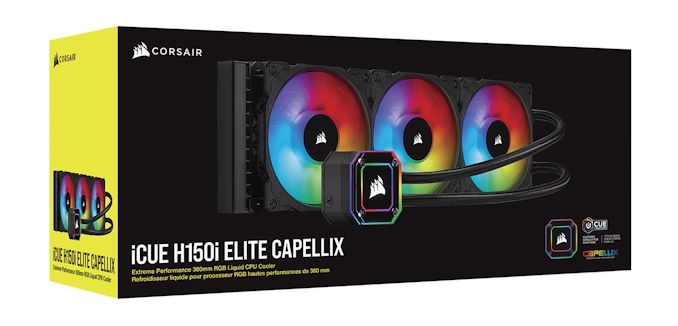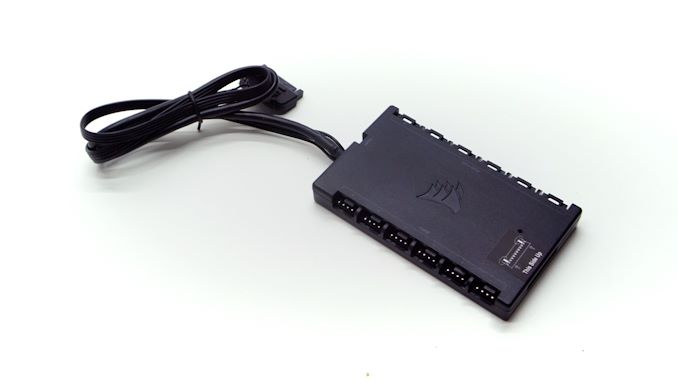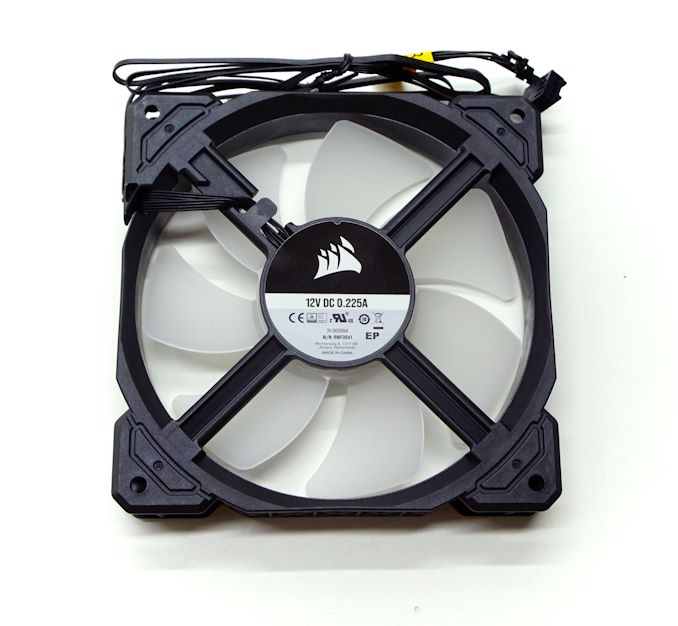The Corsair H150i Elite Capellix AIO Cooler Review: Go Big Or Go Home
by E. Fylladitakis on October 15, 2020 9:30 AM EST- Posted in
- Cases/Cooling/PSUs
- Corsair
- Water Cooling
- Liquid Cooling
- RGB
- iCUE

Corsair is one of the oldest and most reputable PC component manufacturers in the PC market. The company’s origins lie with memory-related products but, nearly two decades ago, the company slowly began diversifying into other segments of the market. While their initial attempts were reluctant, releasing but a couple of products each time, most of these attempts were highly successful and drove the company to grow massively into the entrepreneurial (and recently IPOed) giant that they are today.
These days, one of Corsair’s most successful product segments is that of all-in-one (AIO) liquid coolers – an ironic outcome considering that liquid coolers were the company’s first unsuccessful diversification attempt back in 2003. Corsair did not give up on liquid cooling though and several years later, when simple and maintenance-free AIO cooler designs appeared, Corsair successfully launched their own AIO coolers. Today, AIO coolers are one of Corsair’s most popular group of products, with the company retailing over a dozen different models at this point of time.
In this review we're taking a look at our first cooler from Corsair's new Elite Capellix series of AIO coolers, the H150i Elite Capellix. Like previous H150 AIO coolers, this is a 360mm (3x120mm) cooler, the largest that Corsair makes and ostensibly offering the best cooling performance thanks to its hefty radiator size. For cases that can fit the sizable cooler, the H150 series typically addresses both end of the performance spectrum, offering modest cooling at very low fan speeds (and thus noise levels), or top-tier cooling at more normal fan speeds.
For their new Elite Capellix generation of coolers, Corsair has given their product lineup another layer of polish. Along with incorporating the latest and greatest from Corsair in terms of MagLev fans and pump heads, Corsair has focused on making the Elite Capellix series “Smart” AIO coolers, adding an advanced Commander CORE module into the bundle. A combination fan and RGB lighting controller, the Commander CORE greatly enhances the programming flexibility of the cooler’s performance and lighting features, allowing it to control fans and lighting throughout an entire system.
Packaging & Bundle
We received the new H150i Elite Capellix in a long cardboard box, hinting the size of the cooler. Corsair is currently shipping most of their products in artistically similar black/yellow themed packaging and this cooler is no exception. A colorful picture of the H150i covers the relatively simple front of the packaging. Inside the box we found the cooler and its parts well protected by custom cardboard inserts.
As expected, Corsair includes all of the necessary mounting hardware into the box. The H150i Elite Capellix supports most of the current consumer CPU sockets, including sTR4/sTRX4 for AMD Threadripper CPUs, the mounting hardware for which are also included in the bundle. Corsair also includes an alternative main block cover for aesthetic purposes.
Corsair supplies a Commander CORE module alongside with the H150i Elite Capellix, which essentially is a version of the iCUE Commander Pro RGB controller that the company retails as a stand-alone product, simply tailored to control the RGB lighting of the liquid cooler instead. Nevertheless, it sports six fan power and RGB LED connectors, allowing users to install up to three additional compatible fans, enabling either push-pull configurations or the control of system fans.
The included three ML120 fans feature cutting edge magnetic levitation engines, with their specifications suggesting extraordinary longevity. Unlike all classic designs, these engines magnetically repel the fan’s rotor, greatly reducing friction. Lower friction should lead to significantly superior overall performance and longevity, as well as lower energy consumption, which explains the low current requirement for the rated speed of 2400 RPM. The fans have frosted blades and a black frame, with eight RGB LEDs each.















37 Comments
View All Comments
29a - Friday, October 16, 2020 - link
It has to do with the price of copper vs aluminum.Slash3 - Friday, October 16, 2020 - link
Alphacool and Be Quiet offer full copper block/rad AIOs.Quantumz0d - Thursday, October 15, 2020 - link
I think GN's test shows AiOs being somewhat superior. But as for the Air cooling vs AiO, I will always choose Air coolers. Noctua is top quality and the best part is you get a superb looking beast machine, vs the RGB vomit and cabling issues, and the most important aspect being the lifetime. AiOs always no matter what the coolant will be losing it's efficiency overtime also the particulates in the mixture. Any small leak in any time = death of the data + hard cash. No risks no half measures, only full measures = Air cooling.My build for a long term plan of a PC (usually they can last more than 10 years), will be Noctua Chromax black and red, with no RGB G.Skill B-Die, maybe the mobo / GPU gets a little lighting to make it look even intense of the coloring to match the Chromax.
StevoLincolnite - Thursday, October 15, 2020 - link
My current PC is 11 years old and uses a Corsair Hydro AIO water cooler.No issues.
TelstarTOS - Thursday, October 15, 2020 - link
The usual strategy, performance at price of high noise.Manch - Thursday, October 15, 2020 - link
Short of making the radiator bigger, would adding a reservoir help cooling at this point?Everett F Sargent - Thursday, October 15, 2020 - link
Yes, of course. As long as the reservoir is big enough. Ideally you want the coolant to return to its initial ambient temperature. The major problem with all liquid cooling solutions is an inherent inability to return the coolant back to its original ambient temperature. All you have to do is try to touch the radiator or use an IR digital thermometer.The equation is as simple as Q=VA (Q is the flow rate in liters per second) and the coolant volume or total amount of coolant in the loop, VC = liters, so that VC/Q = seconds or mean residence time, the bigger that number the better chance you have of returning the coolant to its original ambient temperature. The goal is to maintain the maximum delta temperature between the coolant and the CPU. Hot (to the touch or via IR thermometry) radiators defeat the entire exercise (or some fraction thereof) to begin with in the 1st place.
Tomatotech - Friday, October 16, 2020 - link
You are correct in that coolant volume is a factor, however heat flow rate from the radiator is also a large factor. For the same size radiator, factors affecting heat flow would be: thermal conductivity of the radiator, exposed surface area of the radiator, airflow across the radiator. If any of these are very high then cooling* will be effective even with tiny coolant volume.*Reduction of increase in temperature above internal working temperature of CPU. Over time, all radiator systems, even maximally efficient ones, will reach a temperature of at least the internal temperature of the CPU.
Everett F Sargent - Friday, October 16, 2020 - link
Yes there are many factors, but I think my basic claim still holds true. Keeping the coolant temperature low is a must, or preferred, all other things being equal. But I think I will do a little more on quantifying those calculations with my new build.Everett F Sargent - Thursday, October 15, 2020 - link
Go bigger or go home ...https://www.performance-pcs.com/water-cooling/aio-...
Currently out of stock as I got the last one.